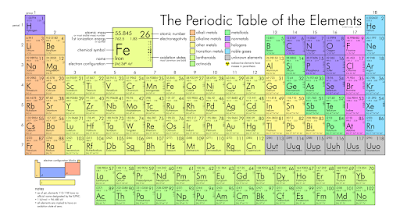Memorizing the Periodic Table just got even harder.
On December 30, 2015 the International Union of Pure and Applied Chemistry, a scientific nongovernmental body, formally announced that four new elements will be added to the periodic table, rounding out the seventh row of this well-known chart.
The new elements are all classified as "super-heavy" radioactive substances, meaning they have more than 104 protons. They were created using particle accelerators and, like other super-heavy elements, exist for only a brief moment—as little as a fraction of a second—before decaying.
The elements are known by temporary names based on the number of protons each contains in its nucleus: ununtrium (element 113), ununpentium (115), ununseptium (117), and ununoctium (118). According to the Union of Pure and Applied Chemistry (IUPAC), "the discoverers from Japan, Russia and the U.S.A. will now be invited to suggest permanent names and symbols."
New elements can be "named after a mythological concept, a mineral, a place or country, a property or a scientist," according to the IUPAC. The proposed names and symbols will be checked by the Inorganic Chemistry Division of IUPAC for consistency, translatability into other languages, possible prior historic use for other cases, etc.
The new elements are all classified as "super-heavy" radioactive substances, meaning they have more than 104 protons. They were created using particle accelerators and, like other super-heavy elements, exist for only a brief moment—as little as a fraction of a second—before decaying.
 |
| Periodic Table with Temporary Names for New Elements |
New elements can be "named after a mythological concept, a mineral, a place or country, a property or a scientist," according to the IUPAC. The proposed names and symbols will be checked by the Inorganic Chemistry Division of IUPAC for consistency, translatability into other languages, possible prior historic use for other cases, etc.
Then the names and two-letter symbols will be presented for public review for five months, before the highest body of IUPAC, the Council, will make a final decision on the names of these new chemical elements and their two-letter symbols and their introduction into the Periodic Table of the Elements.
 |
| Copernicus |
Three of the elements—designated with atomic numbers of 115, 117 and 118—were first detected more than a decade ago by researchers at the Joint Institute for Nuclear Research in Russia and the Lawrence Livermore National Laboratory in California. The fourth, with an atomic number of 113, was discovered in 2004 by the Riken research institute in Japan, making it the first element to have been discovered in Asia. Kosuke Morita, who led the research, said his team searched for more than seven years for data to identify the element.

"We just never saw another event," he said. "I was not prepared to give up, however, as I believed that one day, if we persevered, luck would fall upon us again."
And so it did on August 12, 2012, when the group observed the crucial third event. Former Riken president and Nobel Laureate in chemistry Ryoji Noyori told the Guardian: "To scientists, this is of greater value than an Olympic gold medal".
"The chemistry community is eager to see its most cherished table finally being completed down to the seventh row. IUPAC has now initiated the process of formalizing names and symbols for these elements " said Professor Jan Reedijk, the President of the Inorganic Chemistry Division of IUPAC.
Unfortunately, as science teachers know, textbooks often don't keep up with the times. So it could be quite a few years before students see that completed seventh row in their chemistry textbooks.
That's what makes Excel Math so great. Lessons are updated throughout the year so you never have to worry about whether you have the latest materials. Take a look at sample Excel Math lessons for Kindergarten through Sixth grade on our website: www.excelmath.comUnfortunately, as science teachers know, textbooks often don't keep up with the times. So it could be quite a few years before students see that completed seventh row in their chemistry textbooks.
Ready to place an order? Visit our web store: https://excelmath.myshopify.com/
You may also enjoy these articles:

Financial Awareness for Students
Calming the Frenzy Over Fractions



No comments:
Post a Comment
Type your comment here